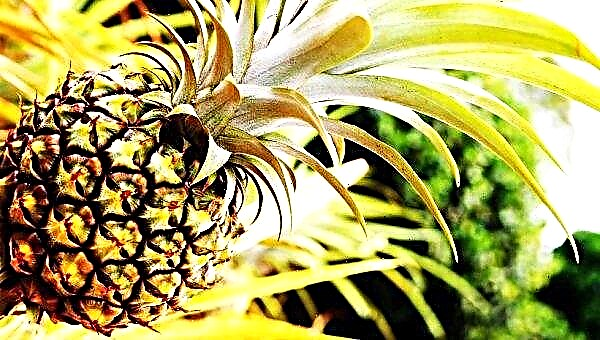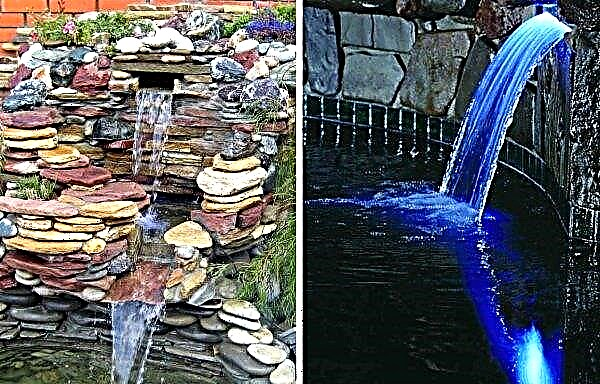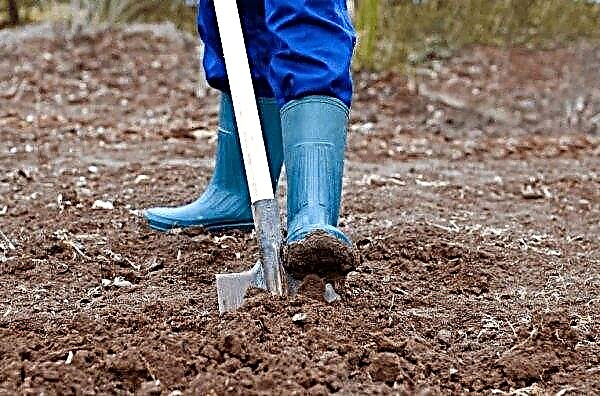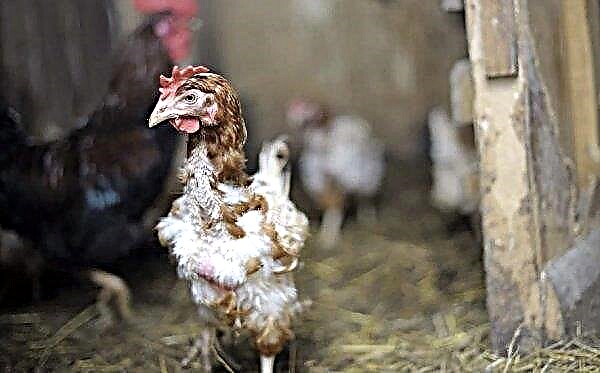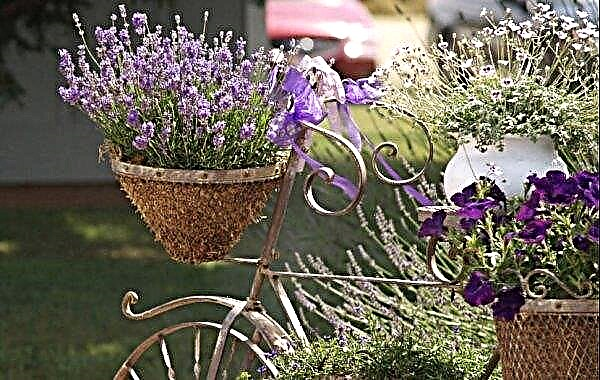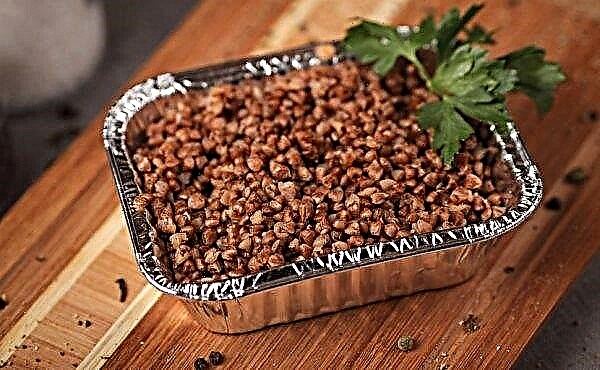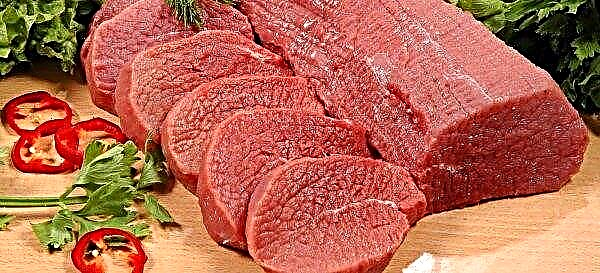Early tomato varieties are not uncommon now, but if you want to enjoy a rich harvest, then you should consider the option of growing tomatoes "Red-red F1". This hybrid is good for greenhouses and greenhouses, and will be able to surprise with large juicy tomatoes at the end of June. We offer you to learn more about it, as well as evaluate the possibility of appearing on your site.
Grade description
Hybrid "Red-red F1" - a new breeding development of the Chelyabinsk station. Tomato is resistant to most diseases of the species. Suitable for cultivation in the middle lane, cold rainy summer conditions. It gives stable crops when planting in closed ground (greenhouses, greenhouses). When breeding in warm climatic conditions, landing in open ground is allowed.
Features of "Red-red F1", which should be considered in agricultural technology:Did you know? From a botanical point of view, a tomato is considered a berry. He became a vegetable in 1893 after a meeting of the US Supreme Court. As one of the strong evidence at the hearing, the fact was cited that the tomato was not cooked for dessert, but was eaten after the first dish along with meat and fish.
- matures quickly, positioned as an early variety;
- indeterminate type, which means that the plant is not limited in growth;
- requires the formation of a bush and herding, needs a garter;
- forms a long stem, about 2 meters in height and a lot of green mass from leaves and stepsons;
- medium-sized leaves of a dark green color, grow quickly;
- on each brush up to 7 fruits can form;
- the shape of the fruit is round, there is a slight ribbing at the peduncle;
- the color of the fruit is bright red;
- high mass of tomatoes: 200-400 g, in the lower hands the fruits are the largest;
- the peel is thin but dense;
- the flesh is loose, sugar on a break, with a small number of seeds;
- high productivity: 8 kg of tomatoes from one bush;
- planting density: 2-3 bushes per 1 square. m;
- Tomato ripenes well, without losing taste.
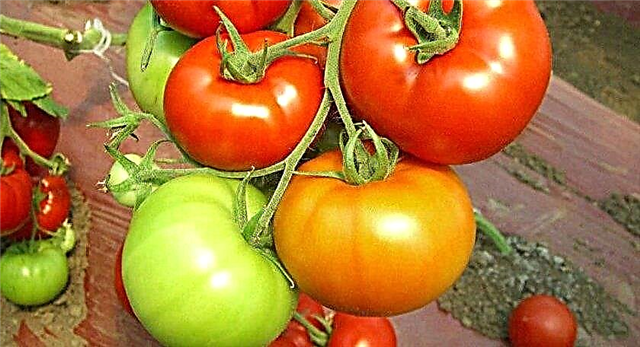
Advantages and disadvantages
- Among the advantages of the hybrid Red-red F1 can be distinguished:
- high yields;
- excellent taste of the fruit;
- unpretentiousness in leaving;
- saturation with useful vitamins;
- resistance to drought and low air temperature;
- Suitability for long-term storage;
- well tolerates transportation and long-term storage;
- universality of application: fresh, preservation, preparation of juices, pastes and other culinary dishes;
- high immunity to solanaceous diseases and pests.
- According to reviews of gardeners growing this tomato hybrid, it has the following disadvantages:
- demanding on the quality of the soil;
- fertilizing with fertilizers or nutritious mixtures is necessary, otherwise productivity decreases;
- has a tendency to overgrow;
- mandatory bush formation and pinching;
- requires tying to a support;
- the inability to grow in regions with a long winter;
- there is no way to collect seed for subsequent germination, therefore, seeds purchased in the store are used;
- varietal characteristics of collected seeds are worse than selection.
Self-growing seedlings
Tomatoes "Red-red F1" are grown from seedlings in seedlings. In open ground, seeds do not germinate, so for their proper development it is necessary to know the agricultural technology of independent breeding of seedlings at home. This is the only way to achieve a good start to plants for harvest.

Sowing dates
The time of planting seeds for seedlings directly depends on the time of planting of plants in the soil and the climatic region. The hybrid "Red-red F1" develops rapidly and is very elongated in growth. Seedlings ready for planting are obtained in 60–65 days. It follows that early sowing of seeds is impractical.
If there is a heated greenhouse on the site, then you can sow seeds in it in early March. For home growing, it is worth starting the process in late March or early April. Such terms are recommended due to the good adaptation of the resulting seedlings and its viability, as well as the fact that the hybrid should carry out its main growth already in the ground at a constant landing site. This will ensure its development and rooting.
The soil
For sowing seedlings, the soil is first prepared. The Red-Red F1 Hybrid will require light but nutritious soil. A prepared mixture of garden soil, peat, turf, humus will do. All components of the mixture are taken in equal proportions and mixed. You can add a little river sand to the soil for loosening, as well as to increase the nutrient medium of sifted wood ash, potash fertilizers and superphosphate.
Mixture for seedlings can be purchased at the store. Preliminarily familiarize yourself with its composition so that it best meets the requirements for growing tomato seedlings.Important! It is good to take land for seedlings in those places where nettle grows, it makes the soil loose and light.
Prepared soil is poured into containers for seedlings and watered abundantly. The seeds are planted the next day.
Capacity for growing
To grow tomato seedlings, you need medium-sized containers. Drawers, plastic or peat glasses will do. The choice of containers is due to the convenience of transporting seedlings to the greenhouse, but the fundamental point is the possibility of organizing drainage and placing containers on the windowsill, where plants can receive maximum lighting.
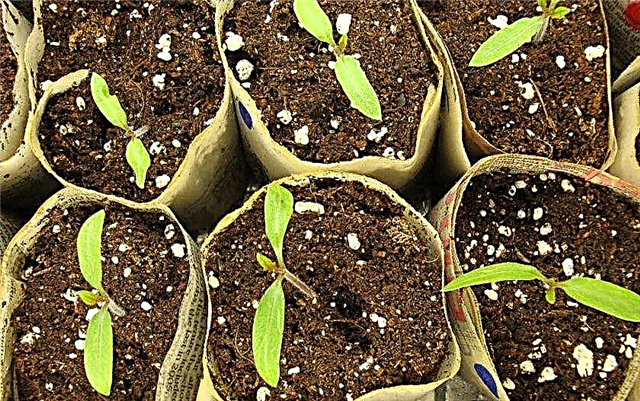
Boxes are convenient for transportation and initial germination of seeds. Peat tablets or pots in which the roots are less injured during transplantation, as well as individual glasses are used at the stage of intensive cultivation of tomato seedlings.
Seed preparation
It is difficult to collect hybrid seeds on their own, since there are few of them in the fruits. Do not forget that this is a hybrid, therefore, in subsequent generations, the properties obtained by breeding are lost, for example, good yield, large fruit size, and disease resistance. With sufficient care, the presence of only this tomato in the greenhouse and the exclusion of pollination by other varieties, you can get almost the same properties, but this is not a guarantee.
Important! For better germination and development of tomatoes “Red-red F1”, not “fresh” seeds are taken for planting, but those that have lain 2–3 years.
If you have collected the seeds yourself, then they are disinfected before planting in a 1% manganese solution, leaving it for 20 minutes, then thoroughly washed with running water. If the seeds were bought at the store, then this procedure is not required, since the manufacturer has already carried out the packaging.
Next, the seeds are treated with a special growth stimulator. In it, the seed is soaked for a day, and then dried without washing.
Sowing seeds
Sowing seeds in prepared containers with soil is carried out according to the following algorithm:
- each seed is buried in the soil by 1.5–2 cm;
- it is necessary to observe the indent between the seeds of 3 cm;
- when the tank is planted, the seeds are covered with earth;
- planting abundantly watered with fine spray;
- from above the container is covered with a transparent cling film or thin glass to create favorable growth conditions;
- containers with seeds are placed in a room where the air temperature will be not less than + 23 ... + 25 ° С;
- until the first sprouts hatch, the illumination of the seed container is not important.

Seedling Care
When the first tomato shoots appear on the soil surface, the film or glass is removed. During germination, the shelter provided comfortable moisture for the seeds, but the evaporation was unnecessary for the shoots. When the soil dries, you can spray it with a small amount of water at room temperature. Try not to overflow: the soil should be moist, but not wet, otherwise the root system will develop poorly in tomatoes.
The first sprouts also mean that it is time to give the plants the maximum amount of light. In the absence of good lighting and a long daylight, it is allowed to use artificial light from fluorescent lamps, energy-saving or special LED phytolamps for seedlings.
Good lighting is necessary for the development of seedlings and limiting its extension in growth. In addition, it is recommended that the container with plants be periodically deployed to the light source on different sides so that all parts develop equally well.
After two leaves appear on the tomatoes, the plant is dived. The procedure is required, as it allows you to create a powerful root system. After this, transplantation into individual containers is recommended, where the plants will develop before they are planted in the ground.
Pick - the time of the first feeding of tomatoes. It is prepared from complex fertilizers, applied in liquid form. The next top dressing will be in 14 days from fertilizers of the same composition. It is carried out before planting seedlings on the beds.

Seedling hardening
Before seedlings of "Red-red F1" will be planted in open ground, it is prepared for this period by hardening. The procedure begins in May, taking containers with plants to a glassed balcony or veranda. The first "walks" last no more than an hour. In a week, you can increase the duration of hardening to a full day.
Planting seedlings in a permanent place
Tomato seedlings "Red-red F1" is ready for planting in the soil 2 months after seed germination. However, the landing in the soil is carried out during the period when the threat of frost at night is completely eliminated.
For different regions, this period varies, therefore, it is recommended to plant a hybrid:
- for a warm climate - May-early June;
- for cool regions - the second decade of June;
- for planting in the greenhouse - mid-May.
Did you know? It is believed that ketchup was invented in America, but a dish with that name was brought from the 17th century from China to England. It was prepared from anchovies, nuts and mushrooms, and absolutely did not contain tomatoes.
The bed for planting seedlings is thoroughly loosened. Next, dig holes in rows for seedlings in it.
Landing pattern:
- the distance between seedlings is 50–80 cm;
- the distance between the rows is 80-100 cm.
If you continue to form plants in one stem, then you can plant up to 4 bushes per square. m. The recommended frequency of planting seedlings is 2-3 bushes per 1 square. m

When planting in a hole, you can pour wood ash or superphosphate. It is good to water soil. An individual hole is intended for each seedling bush, the depth of which should freely accommodate the root system. Plants are placed in holes, sprinkled with earth, rammed and watered again.
Care
Caring for the Red-Red F1 tomato does not differ from complex measures for other varieties of tomatoes: watering, periodic top dressing, weeding and hilling. Each of the stages is important for obtaining the desired crop, because seedlings quickly start growing immediately after planting.

Some gardeners, when growing tomatoes, create special conditions for them with increased temperature and humidity, which contributes to the speedy development of plants. However, one should be careful with the air temperature in the greenhouse. Above +35 ° C, the pollen of the hybrid becomes sterile, and you can get excellent growth and lush flowering of plants, but you can’t wait for the fruit to set.
Watering
Water the tomato "Red-red F1" should be as necessary when drying the soil. Watering volume is moderate. Water intended for irrigation is pre-sedimented and heated under the sun.
In greenhouses and hotbeds it is better to organize drip irrigation of plants. It allows you to economically consume water and deliver moisture directly to the roots of tomatoes. Without drip irrigation, watering is done with a garden watering can, moistening only the roots of the plants. The event is held in the afternoon, in the late afternoon.
When watering, you should adhere to a certain norm, while achieving saturation with moisture and eliminating its excess. It is especially carefully watered during fruit ovary, as excessive moisture can cause cracking of the tomatoes. The first watering is carried out 7-10 days after planting seedlings. Subsequent irrigation is performed approximately 1 time per week.Fertilizer application
Top dressing of the hybrid “Red-red F1” directly affects its productivity.
Fertilizers are delivered during cultivation in several stages:
- during the period of active growth of the bush and before the flowering phase, fertilizing with nitrogen-containing fertilizers is required, which strengthen the plant. Application time - 10-14 days after planting;
- after flowering the type of fertilizer is changed to phosphorus-potash, which improves the formation of ovaries, the formation of fruits and their reddening as soon as possible, while nitrogen fertilizers are no longer used until the end of cultivation. Application time - approximately 2 weeks after nitrogen-containing fertilizers;
- allowed to do several top dressings with infusions manure, bird droppings or compost, especially in cases where cultivation is carried out on depleted soils.
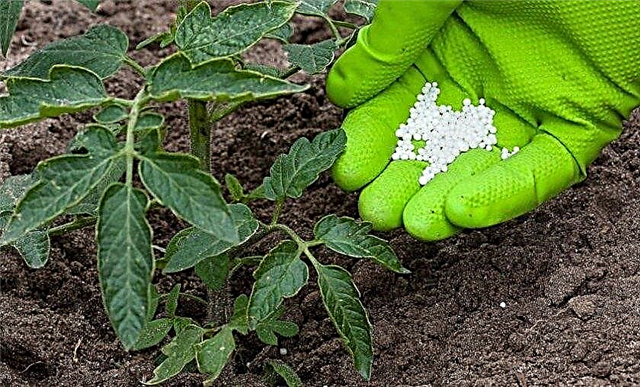
Stepson
The bush “Red-red F1” grows unlimited in height, forms new shoots and leaves. There is a lot of green mass, and it slows down fruiting. Therefore, for the hybrid, the timely formation of a bush and pinching are important.
Hybrid high-yielding varieties of tomatoes form in one stem. This is achieved by removing all the lateral processes (stepsons) from the bush. In addition to stepsons, it is recommended to remove all leaves from the stem to the first brush with fruits. Inspection of the bushes for the presence of new processes should be carried out 1-2 times a week.
Important! It is not necessary to remove the stepsons entirely under the stem itself, but to leave a small “leg” to prevent the shoots from reappearing in the same place. The leaves are torn sideways to keep the stem peel intact.
At this, the activities on the formation of the bush do not end there. The tomato can grow in height as much as the greenhouse allows, but the ceiling does not stop it. Therefore, in order for all the fruits to gain enough mass and ripen until the end of the season, pinching is done to the Red-Red F1 bush.
After the last brush, a couple more leaves are left, and the top of the head is removed. For greenhouses, the cultivation rate is 7 fruit brushes, and for open ground - 5. Usually this period is the end of July - the beginning of August.
Along with the formation of the bush, you should pay attention to the quality of the flowers on the brush. Underdeveloped or deformed inflorescences are removed.
Video: How to plant tomatoes properly
Soil care
Soil care consists in timely cleaning of weeds between rows of tomato beds. Careful weeding is important during the period of active growth of still weakly grown tomato seedlings. Also, black cover material is often used to control weeds, which is laid directly on the soil.
To ensure good air exchange for the roots, it is recommended to loosen the soil. However, do this by slightly departing from the stem so as not to damage the root system, which is a surface type tomato. Instead of loosening, mulching with peat, straw or hilling the stem is more useful. You can spud several times until the fruits begin to set.
Tying bushes
Tall tomato stems need to be tied. Garter helps to organize air circulation between plants, simplifies watering and top dressing of plants, makes it easy to conduct pinching. The hybrid “Red-Red F1” forms heavy brushes with large fruits, so they are also tied up to prevent breakage.
The stem is strengthened in several ways:- Simplest - using pegs, which are deepened by 20 cm, away from the stem. The hybrid can grow up to 1.5–2 m, so the material for the stakes should be immediately selected the appropriate length. Also need material for a garter (preferably synthetic).
- Linear way involves the installation of a bar at each end of the bed, between which the wire is stretched horizontally. A tomato stalk is tied to it.
- Tapestry method convenient in terms of less consumption of pegs that drive only at the ends of the rows. Between the stakes a strong horizontal trellis is installed (wire, rod, dense twine), capable of withstanding the mass of tomato bushes. The stalks of tomatoes are attached to the trellis.
- In the garden shop you can buy plastic kits for tying tall tomatoes. Such gratings are convenient and will last several seasons.

Harvesting
Harvesting for tomatoes "Red-red F1" is a continuous process. A lot of fruits are formed on the branches, and they ripen in stages. It is recommended not to wait for full ripening to a saturated red color, as ripening inhibits the growth of fruits on the upper brushes. Vegetables are allowed to be removed from the bush and unripe. With artificial ripening, the taste of the tomato is not lost.
See also other indeterminate tomato varieties:
Gather tomatoes daily or every other day. This is necessary not only in favor of the remaining tomatoes on the bush, but also for security purposes. The fruits of the hybrid are heavy, and if several giants accumulate on the hands, it can break off.
To extend the shelf life, you can remove the tomatoes with the stem. It is recommended to harvest before the evening cool, excluding the early morning when the dew sits. If you pick the fruits from the bush on time, then you can achieve good yield indicators and get fresh Red-Red F1 tomatoes before the fall.

Scientists have found that in tomatoes there is serotonin, which is also known as the hormone of happiness, as well as thiamine, from which our body again synthesizes serotonin. This means that tomatoes can work perfectly as natural antidepressants. Therefore, grow "Red-red F1", get excellent tomato harvests and be happy!

